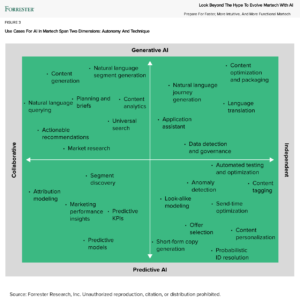Art Offers An AI Reality Check For Martech
Hanging prominently in the Museum of Modern Art (MoMA) in New York City is a giant infographic that explores the physical, technical, and social components of modern artificial intelligence. Kate Crawford and Vladan Joler’s 2018 “Anatomy of an AI System” is a visual essay that spares no detail as it traces the lifecycle of an Amazon Echo from manufacturing to data modeling to, ultimately, device disposal. The piece affirms the value of AI but offers a powerful rebuttal to the popular notion that AI effortlessly makes everything automated, fast, and simple.
AI has a rarely acknowledged gritty underbelly; it’s technically complex, requires intense collaboration, and follows an extensive lifecycle. Our esteemed researcher, Cole Walsh, recently spent a dizzying hour at MoMA in front of this work of art and contemplated: In today’s generative AI (genAI) swirl, how can B2C marketers get a holistic AI primer and effectively prepare to leverage AI in their work?
Key developments in generative AI made it one of the hottest topics for business leaders in 2023. B2C marketers were not immune: 26% of US B2C marketing executives in Forrester’s Q4 2023 B2C Marketing CMO Pulse Survey said that they already use genAI in their marketing efforts. The promise of genAI is enticing: faster creative development, natural language querying, and more. And even while AI has quietly supported martech for over a decade in myriad ways, these capabilities are advancing every day. Meanwhile, most marketers possess a buzzword-level grasp of AI and are acutely aware that they need to get up to speed quickly or risk falling behind.
Much like Crawford and Joler’s piece at MoMA, our new report, Look Beyond The Hype To Evolve Martech With AI, helps marketers make sense of AI mania. We envision generative AI progressing in martech in creative development in the short term, in insights and marketing ops over the middle term, and in customer journeys for the long term. While we wait for that progression to play out, consider the following:
- Autonomy: collaborative vs. independent. How much does AI in martech function without the marketers? Some AI capabilities work in lockstep with human actions, inputs, and evaluation, whereas other AI capabilities function independently, with the primary burden on the machine.
- Technique: predictive vs. generative. Predictive AI has existed for far longer than generative AI, helping marketers identify likely future outcomes based on historical data (propensity, affinity, demographics, etc.). GenAI is a newer set of technologies and techniques that leverage massive corpora of data to create original content (text, images, code, etc.).

Moving forward, marketers will need to arm themselves for future AI advancements with sufficient data, continuous monitoring of genAI outputs, measurement to justify ongoing investment, and comprehensive privacy and security practices. This will require sidestepping the hype and allocating significant resources to ensure that marketing AI execution drives value for the business and value realization for customers.
We’re here to help you put in the work. Want to chat further about AI in martech? Schedule an inquiry or guidance session with us.
